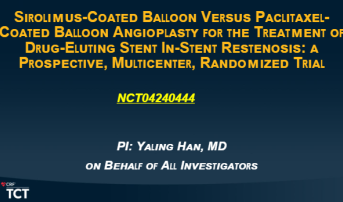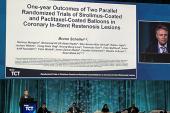Sirolimus- and Paclitaxel-Coated Balloons Well-Matched for In-Stent Restenosis
The newer, sirolimus DCB was noninferior on angiography, but additional clinical studies with longer follow-up are needed.

SAN FRANCISCO, CA—In patients with in-stent restenosis after drug-eluting stent implantation, a sirolimus-coated balloon (SeQuent SCB) provides noninferior angiographic results at 9 months compared with a balloon coated in paclitaxel (SeQuent Please Neo; both B. Braun Melsungen AG), according to the results of a randomized trial.
Late lumen loss at 9 months was 0.35 with the sirolimus-coated balloon (SCB) and 0.31 with the paclitaxel-coated balloon (PCB), with the difference of 0.05 mm (95% CI -0.0523-0.1476) meeting criteria for noninferiority with a margin of 0.2 mm.
Clinical outcomes, including target lesion failure (TLF) and patient-oriented composite endpoints (POCE), were similar with the two balloons at 12 months. “A further clinical trial is warranted to identify the improvement in clinical events by [SCB] for patients with in-stent restenosis after implantation DES,” said investigator Shao-Liang Chen, MD, PhD (Nanjing First Hospital, Nanjing Medical University, China), last week at TCT 2023.
Ajay Kirtane, MD (NewYork-Presbyterian/Columbia University Irving Medical Center, New York, NY), who moderated a press conference at which the results were discussed, noted that there are numerous SCB and PCB available (though none have been approved in the United States), saying that “these types of comparative studies are important to have to be able to identify” potential differences between devices.
When it comes to comparing balloons coated with sirolimus versus paclitaxel, Kirtane pointed out that “paclitaxel has certain properties that allow it to remain in the tissue and keep its levels there for a long period of time, and sirolimus doesn’t do that. And so you need a specific formulation of sirolimus to allow that to occur.” He added that there could be other differences in terms of manufacturing, storage, or other factors, too.
Kirtane, study chair of the positive AGENT IDE trial evaluating a paclitaxel-coated balloon in the setting of in-stent restenosis, indicated that having multiple options for drug-coated balloons could help drive down price while offering a broader selection of products. “Having more options when they come out will hopefully allow more patients, hospitals, [and] physicians to be able to use them,” he added.
Sirolimus vs Paclitaxel
In the parts of the world where these devices are available, a PCB is the preferred treatment for in-stent restenosis after DES implantation, Chen said, noting that SCB present some technical challenges stemming from the elution properties of the drug. A prior animal study, he noted, showed that with an SCB using butylated hydroxytoluene as a vehicle for drug delivery, about 50% of the initial concentration of the drug remained in the vessel wall at 1 month.
To further explore the impact of such a device, he and his colleagues conducted a randomized trial at 16 centers in China that was designed to be an investigational device exemption trial for regulatory approval of the SCB in that country. Investigators randomized 258 patients (mean age 64 years; 74% men) who had ischemia induced by in-stent restenosis, no more than two restenotic lesions, a vessel diameter of 2.5 to 4.0 mm, and a lesion length of 34 mm or less; patients had a total of 290 lesions treated.
According to the Mehran classification, most lesions (about 60%) were type II, about 25% were type I, and 15% were type III/IV.
The primary endpoint was late lumen loss within the stented segment at 9 months, with the SCB proving noninferior to the PCB. Other angiographic endpoints were similar in the two groups as well. Binary restenosis occurred in 17.9% of patients treated with the SCB and 15.0% of those treated with the PCB.
At 12 months, TLF (a composite of cardiac death, target-vessel MI, or clinically driven TLR) had been recorded in 13.1% of SCB-treated patients and 11.0% of PCB-treated patients (P = 0.61), with no differences in any of the individual components of the endpoint. POCE, which incorporated all-cause mortality, any MI, or any revascularization was seen in 21.5% and 20.5%, respectively (P = 0.83). Rates of any revascularization were 20.0% and 18.1% (P = 0.70).
How to Choose
Bruno Scheller, MD (Saarland University, Homburg/Saar, Germany), who elsewhere at TCT 2023 reported favorable results regarding the SCB in de novo coronary lesions, served as the discussant following Chen’s presentation. He said the strengths of the current trial include the participation of a large number of centers, the number of patients, the use of a mechanistic primary angiographic endpoint, and the high rate of follow-up despite the obstacles posed by the COVID-19 pandemic.
The study established noninferiority for the primary endpoint and showed no difference in clinical outcomes, and “those results confirm the outcome of two prior randomized trials with the same DCB, conducted in Malaysia and Germany/Switzerland in the same indication, in-stent restenosis.”
Although the trial is limited by the open-label design and the lack of power to look for difference in clinical endpoints, “it provides confirmatory evidence for the biological efficacy of the sirolimus-coated balloon in terms of limiting neointimal formation up to 9 months,” Scheller said. He noted, however, that the late lumen loss in this trial was somewhat higher than what was seen in the other trials, possibly a reflection of differences in lesion preparation.
But Chen cautioned against comparing trial results, suggesting that the disparate findings regarding late lumen loss could be due to differences in the complexity of the lesions treated in the studies.
As for how to choose between all of the different types of DCB that are available to operators outside of the US, Margaret McEntegart, MD, PhD (NewYork-Presbyterian/Columbia University Irving Medical Center), who used to practice in the United Kingdom, said during a panel discussion following Chen’s presentation that “often what I would do, certainly for the return patient, is if I’d used one and they came back, I’d use a different one the next time. So I think we’re not sure actually. I think we still need more data to guide that.”
Addressing that point, fellow panelist Robert Byrne, MBBCh, PhD (Mater Private Network, Dublin, Ireland), said, “I suppose, for most of us, we’ve been dependent on paclitaxel-coated balloons over the last 10 years because that’s where the data has been at.” But he added that if positive data continue to come out on the SCB, “this will be another good option for us.”
Todd Neale is the Associate News Editor for TCTMD and a Senior Medical Journalist. He got his start in journalism at …
Read Full BioSources
Chen SL. Sirolimus-coated balloon versus paclitaxel-coated balloon angioplasty for the treatment of drug-eluting stent in-stent restenosis: a prospective, multicenter, randomized trial. Presented at: TCT 2023. October 25, 2023. San Francisco, CA.
Disclosures
- The trial was sponsored by B. Braun Medical (Shanghai) International Trading Co. Ltd.
- Chen reports no relevant conflicts of interest.






Comments